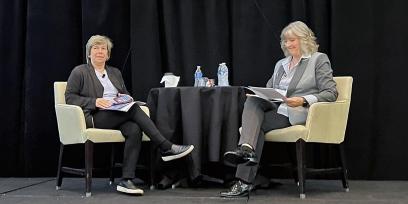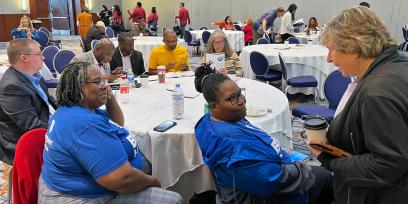Their gaze on the horizon, AFT public employees brainstormed solutions at their professional issues conference, tackling the most serious issues facing workers in the public sector, from staffing shortages to artificial intelligence to retirement security. They met in Baltimore Nov. 16-18, using the theme, “Focus on the Future: Rebuilding our Communities with a Strong Public Service.”
The conference opened with remarks from Jill Cohenour, chair of the AFT Public Employees program and policy council; Jerry Smith, president of the Maryland Professional Employees Council; and Kenya Campbell, president of AFT-Maryland, who urged members to brag about their achievements because “what you accomplish can show someone else what is possible.”
Antoinette Ryan-Johnson, president of the City Union of Baltimore, shared the success of a CUB health and safety campaign protecting city workers from hazards on the job. Several employees have moved to safer work spots while others are teleworking until the city makes their work sites safer.
A keynote interview between AFT President Randi Weingarten and Cohenour touched on early influences in Weingarten’s union career, the promise and perils of AI, and the necessity of countering misinformation. Weingarten commended AFT public employees for their proactive approach to AI in the workplace, emphasizing the importance of trust during times of significant change.
An acute shortage of staff
There are nearly 10 million job vacancies nationwide, with almost 1 million unfilled public service positions. AFT Public Employees, after a year of study, will announce 10 strategies early next year to reverse these shortages:
- Negotiate a 35-hour workweek to help both recruit and retain workers. “We can’t bring them in unless we have incentives,” said AFT Public Employees Director Jennifer Porcari. She pointed to Scotland and Australia as models, which already have a 32-hour workweek.
- Evaluate public jobs for hybrid telework options whenever possible. Telework is particularly well-suited to certain employees under the Americans with Disabilities Act. An exception to this strategy is work in facilities open 24 hours a day where employees must be on site, such as prisons, nursing homes and mental health institutions. In those cases, employees could be compensated for the cost of commuting.
- Reduce the pay gap between public and private professionals.
- Create benefit options across the life cycle. Some employees, for instance, may not need child care but are keenly interested in “recharge” leave as a benefit.
- Extend mental health support systems beyond employee assistance programs and other short-term healthcare perks.
- Strengthen defined-benefit pensions to make them equitable and robust. Generation X job candidates can be attracted by true pension plans because this cohort of workers has hardly any money saved for retirement—the mean amount of savings among Gen Xers is $14,000.
- Build a pipeline of workers through apprenticeships, internships, “service year” programs and “second chance” job opportunities.
- Invest in human resources professionals. Theirs is a demanding and complex role that includes recruiting, retaining and supporting job candidates.
- Shorten the timeline for hiring staff. Hiring in government now averages 119 days—three times longer than in private enterprises.
- Update all job descriptions regularly. If you have a job description that looks like it was typewritten or mimeographed, it probably was. Alaska had a surplus labor pool for decades, and employers used to winnow the number of job applicants. Based on union members’ recommendations, the state government rewrote its job descriptions and was able to hire someone who had been out of work for several years.
The arrival of AI
Artificial intelligence is moving faster than we are, “and we have to get ahead of it,” said Wayne Spence, president of the New York State Public Employees Federation and a parole officer. Tools that originated to assist professionals are now replacing the professional judgment of these employees. He pointed to a case study on COMPAS, which was built as one tool to help judges assess the risk of future crime but now is being used as the only tool.
“That’s a really scary place to be,” Spence said. “We know better than an algorithm.”
In one case, COMPAS saw only an offender’s cocaine conviction and missed a murder he had committed, so it put him at a lower risk level, and he was only required to meet with his parole officer every four months. He went on to commit a second murder.
Everyone who works in government has probably seen AI being used to replace employees in work that requires experience and judgment, observed Randi DiAntonio, a PEF vice president and former social worker.
It’s not always apparent when AI is being used. In child protective services, the decision on when to remove a child from the home should be made after social workers visit homes and talk with friends, family and neighbors. “Software is being used to offset staffing shortages,” DiAntonio said. Companies are making big profits “selling a bill of goods to our state entities.”
AI can affect the workforce in both positive and negative ways, Spence said. It can protect workers’ jobs and data. It also can discriminate by race, gender and other factors, depending on its built-in assumptions. Some HR departments are using AI to hire people and evaluate employees for transfer—practices fraught with implicit bias.
PEF’s 2023-26 collective bargaining agreement establishes a joint committee to study the impact of emerging AI on members and work. The union is training elected leaders and plans to inventory all AI used by state agencies.
What can we do together as a union to get a handle on AI? Be sure to send your IT people to the table, Spence said. Call for public hearings and training or retraining if jobs become obsolete. Protect civil liberties and prevent discrimination. Start asking questions because even if you don’t get an answer, that’s an answer. “The more of us getting onboard with fighting these fights, the more success we will have,” he said.
Amanda Ballantyne, director of the AFL-CIO Technology Institute, said unions can play a crucial role in guiding AI because union members know what works and does not work to do their jobs well.
Ballantyne figures we’ve got about three years to get AI right.
Artificial intelligence is new but technological disruptions are not new, observed James Maroney, a state senator from Connecticut, recalling disruptions to automotive manufacturing in the middle of the 20th century. Technology designed for the majority, he said, misses outliers and minorities. Seat belts were originally designed only for men because men did most of the driving.
And safety? That’s where unions come in. When electricity was first commercialized, Ballantyne said, it killed lots of people, burned down houses and was completely unregulated. The International Brotherhood of Electrical Workers got that technology regulated. Bargain language into your contract that requires advance notice of AI, she said, and explains what the technology is allowed to do.
Pensions: a key incentive
Defined-benefit pensions, traditionally a cornerstone of public service job benefits, have faced challenges in recent decades due to underfunding and a shift to defined-contribution plans. Dan Doonan, executive director of the National Institute on Retirement Security, highlighted negative impacts on employee retention in Alaska, where the loss of public pensions led to attrition in the public sector. This is also a reason why younger workers are staying away from public service.
Alaska, a state three times the size of Texas with a population the size of Vermont, has a dire employee retention problem since losing its public pensions, Doonan said. To put it in perspective, California is getting three times the years of service from its new hires (1,800 years) compared with Alaska (600 years).
Jeff Kasper, business manager for the Alaska Public Employees Association, described how the state Legislature decided, based on bad actuarial advice, to eliminate pensions for public employees. The state eventually sued the actuary and won—but the damage was done. People are now working five years to get vested in their defined-contribution plan, then leaving. Alaska has become a training ground for many professions at the expense of the public. “It’s just not an incentive for people to go into public service anymore,” Kasper said.
In response, unions have banded together in a coalition to restore pensions.
The ripple effects from worker shortages in public service are profound. Take snow removal, Kasper said. If you don’t have enough plow drivers on the job in Alaska, residents of an entire region can’t work or go to school for a week.
Gary Feist, president of North Dakota Public Employees and a state corporate tax auditor, recounted how the state Legislature there decided to close its pension plan without any actuarial study at all. It also passed a costly law that everyone who left the pension plan could come back for a fee; they all came back.
Last but not least is the inequity of having tiers of older, mostly white public employees receiving traditional pensions while younger people of color do not.
The city of Grandview, Mo., is advertising jobs with this selling point: “Your mom called. She said to get a job with a pension.”
Defending democracy through public service
Two AFT heroes donned superhero capes for the closing plenary to illustrate the fact that every employee who provides public services is defending democracy. Jan Hochadel, president of AFT Connecticut, asked members how they felt on Jan. 6, 2021. Mary Cathryn Ricker, executive director of the Albert Shanker Institute, said she felt as though all public employees were under siege: “Up until that attack, to be honest, I was not aware that we were that vulnerable.”
Mostly, members remembered feeling anger, shock, dread and sadness. And they carried on doing their jobs, moving the work forward, in Ricker’s words, “to meet the needs of the people.” They kept the streets paved and plowed, the public libraries open and performed myriad other services to help people thrive.
Ricker and Hochadel emphasized the crucial role of public employees in upholding democracy and pledged to work through their unions to register voters, promote literacy, counter misinformation, endorse candidates for public office, ease voter suppression and support access to the ballot box. They promised to educate their own members on the connection of their work to the public good.
For more information on short staffing of public employees, AI in the public sector, or public service pensions, contact PublicEmployees@aft.org.
[Annette Licitra]


